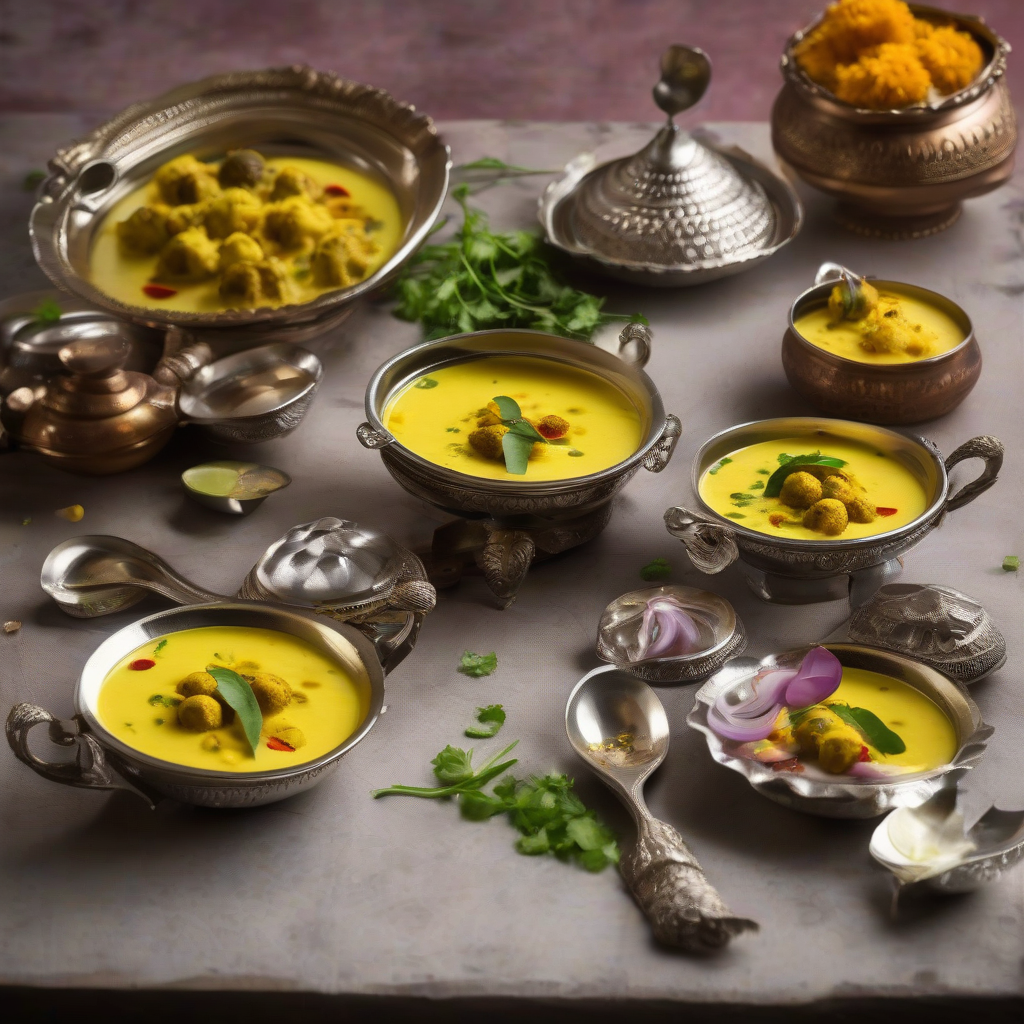Kadhi Badi Bliss: A Taste of Home, Made with Love!
Namaste Doston! Sat Sri Akal! Kem Chho? Chef Curry Do-Pyaza here, ready to whisk you away on a culinary journey to the heart of India! Today, we’re diving deep into a dish that’s as comforting as a warm hug from your nani (grandmother): Kadhi Badi!
This vibrant, tangy, and utterly delicious dish is a staple in many North Indian homes. It’s a symphony of flavors, a dance of textures, and a celebration of simple ingredients. Think of it as sunshine in a bowl, perfect for those gloomy monsoon days or festive occasions like Diwali, Holi, or even a simple family pooja (prayer ceremony). Kadhi Badi is also a popular dish during the fasting period of Navratri, as it provides sustained energy and satisfies the taste buds.
A Little Trip Down Memory Lane…
Kadhi, in its various forms, has been around for centuries. Its origins are often traced back to Rajasthan and Gujarat. The beauty of Kadhi lies in its adaptability – every region, every family has its own special twist. The addition of badis (fried lentil dumplings) elevates the dish to a whole new level of deliciousness!
Get Ready to Cook!
Preparation Time: 20 minutes
Cooking Time: 35 minutes
What You’ll Need (Ingredients):
For the Kadhi (Gravy):
- 1 cup Besan (Gram Flour)
- 4 cups Dahi (Yogurt), whisked until smooth
- 4 cups Pani (Water)
- 1 tbsp Adrak-Lahsun Paste (Ginger-Garlic Paste)
- 1 tsp Haldi Powder (Turmeric Powder)
- 1 tsp Lal Mirch Powder (Red Chilli Powder)
- 1 tsp Dhaniya Powder (Coriander Powder)
- Namak (Salt) to taste
- 2 tbsp Tel (Cooking Oil)
- 1/2 tsp Jeera (Cumin Seeds)
- 1/4 tsp Methi Seeds (Fenugreek Seeds)
- 1/4 tsp Hing (Asafoetida)
- 2-3 Sukhi Lal Mirch (Dry Red Chillies)
- A few Curry Patta (Curry Leaves)
- 2 tbsp Hara Dhaniya (Fresh Coriander Leaves), chopped for garnish
For the Badi (Lentil Dumplings):
- 1 cup Moong Dal (Yellow Lentil), soaked for at least 4 hours
- 1/2 inch Adrak (Ginger), grated
- 1-2 Hari Mirch (Green Chillies), finely chopped
- Hing (Asafoetida), a pinch
- Namak (Salt) to taste
- Tel (Cooking Oil) for deep frying
Let’s Get Cooking! (Step-by-Step Instructions):
- Making the Badi: Drain the soaked moong dal and grind it into a coarse paste. Don’t add too much water! Add the grated ginger, chopped green chillies, hing, and salt. Mix well.
- Heat tel (oil) in a kadai (wok) or deep frying pan. Drop small spoonfuls of the dal mixture into the hot oil and fry until golden brown and crispy. Remove and set aside. These are your delicious badis!
- Preparing the Kadhi: In a large bowl, whisk together the besan, dahi, and water until smooth. Make sure there are no lumps! Add the ginger-garlic paste, turmeric powder, red chilli powder, coriander powder, and salt. Mix well.
- Cooking the Kadhi: Heat tel (oil) in a large pot or kadai. Add the jeera, methi seeds, and hing. Let them splutter. Then add the dry red chillies and curry leaves.
- Pour the besan-dahi mixture into the pot. Bring it to a boil, stirring constantly to prevent it from sticking to the bottom.
- Once it comes to a boil, reduce the heat and let it simmer for at least 20-25 minutes, stirring occasionally. The longer it simmers, the thicker and more flavorful it becomes!
- Add the fried badis to the kadhi and simmer for another 5-10 minutes. This allows the badis to soak up the delicious gravy.
- Garnish with fresh coriander leaves and serve hot!
Chef Curry’s Top Tips:
- Whisk, Whisk, Whisk! Make sure the dahi and besan mixture is perfectly smooth to avoid lumps in your kadhi.
- Patience is Key! Simmering the kadhi for a longer time is crucial for developing a rich, tangy flavor.
- Adjust the Spice! Feel free to adjust the amount of red chilli powder to suit your taste.
- Fresh is Best! Use fresh dahi for the best flavor.
- Badi Size Matters! Keep the badis small for even cooking and soaking.
Kadhi Badi Your Way! (Different Cooking Methods):
- Gas Stove: The classic method! Follow the instructions above.
- Induction Stove: Works perfectly well! Just adjust the heat settings accordingly.
- Pressure Cooker: Not recommended, as the dahi can curdle.
- Oven: Not suitable for this recipe.
- Microwave: Not recommended for the best flavor.
- Air Fryer: You can air fry the badis instead of deep frying for a healthier option.
- Slow Cooker/Crockpot: This is a great option! Combine all the kadhi ingredients in the slow cooker and cook on low for 6-8 hours. Add the badis during the last hour.
Nutrition Notes:
Kadhi Badi is a good source of protein, carbohydrates, and probiotics (from the yogurt). It’s also rich in vitamins and minerals. However, keep in mind that the fried badis do add to the calorie count.
Serving Suggestions:
- Serve hot with steamed chawal (rice).
- Pair it with roti or paratha for a hearty meal.
- A dollop of ghee (clarified butter) adds richness and flavor.
- A side of papad (thin, crispy flatbread) completes the experience.
Your Turn!
Now it’s your turn to bring this delightful Kadhi Badi to life in your own kitchen! Don’t be afraid to experiment and add your own personal touch. Share this recipe with your friends and family and spread the joy of good food! Happy Cooking!
Until next time, keep smiling and keep cooking!
Chef Curry Do-Pyaza signing off!
